Möchten Sie WordPress in einem Unterverzeichnis installieren?
Die Installation von WordPress in einem Unterverzeichnis ermöglicht es Ihnen, mehrere WordPress-Instanzen unter derselben Domain oder sogar unter einem Subdomainnamen zu betreiben.
In diesem Artikel zeigen wir Ihnen, wie Sie WordPress ganz einfach in einem Unterverzeichnis installieren können, ohne den übergeordneten Domainnamen zu beeinflussen.
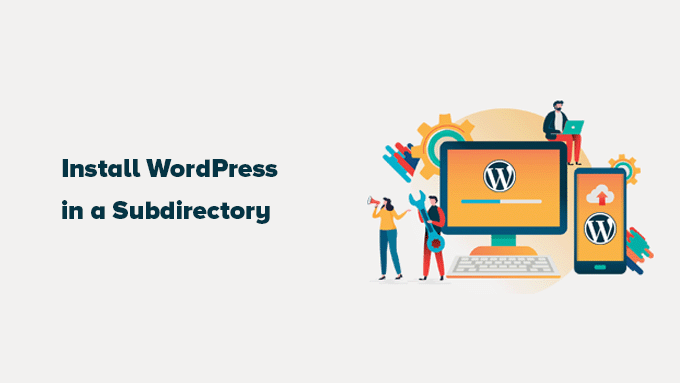
Subdomain vs. Unterverzeichnis: Was ist besser für SEO?
Normalerweise würden Sie eine WordPress-Website unter einem eigenen Domainnamen starten (z. B. wpbeginner.com).
Es kann jedoch vorkommen, dass Sie zusätzliche Websites unter demselben Domänennamen erstellen möchten.
Dies kann entweder durch die Installation von WordPress in einer Subdomain (http://newebsite.example.com) oder als Unterverzeichnis (http://example.com/newwebsite/) geschehen.
Eine Frage, die uns immer wieder gestellt wird, ist die, welche für SEO besser ist.
Suchmaschinen behandeln Subdomains anders als Root-Domain-Namen und vergeben Rankings als separate Websites.
Zum Beispiel betrachten Suchmaschinen WPBeginner und unsere WPBeginner Videos Seiten als separate Websites.
Andererseits profitieren Unterverzeichnisse direkt von der Domain-Autorität der Root-Domain und rangieren daher in den meisten Fällen höher.
Eine Möglichkeit, separate WordPress-Sites in beiden Subdomains oder Unterverzeichnissen zu erstellen, ist die Installation eines WordPress-Multisite-Netzwerks.
Wenn Sie jedoch zwei Websites getrennt verwalten möchten, können Sie verschiedene Instanzen von WordPress installieren.
Sie können auch WordPress-Site-Management-Tools verwenden, um ein einziges Dashboard für die Verwaltung mehrerer WordPress-Installationen einzurichten.
Voraussetzungen für die Installation von WordPress in einem Unterverzeichnis
Es gibt keine besonderen Anforderungen für die Installation von WordPress in einem Unterverzeichnis. Sie können loslegen, wenn Sie bereits eine WordPress-Website in der Stammdomäne haben.
Wenn Sie jedoch eine statische (nicht-WordPress-Website) haben, müssen Sie möglicherweise bei Ihrem Hosting-Unternehmen nachfragen, ob es WordPress unterstützt.
Wenn nicht, müssen Sie Ihre Website zu einem anderen Hosting-Unternehmen umziehen.
Wir empfehlen die Nutzung von Bluehost. Sie bieten WPBeginner-Nutzern einen großzügigen Rabatt auf das Hosting mit einem kostenlosen Domainnamen.
Wenn Sie einen anderen Hosting-Anbieter verwenden, können Sie bei allen führenden WordPress-Hosting-Anbietern ganz einfach mehrere WordPress-Websites mit demselben Hosting-Konto installieren.
Wenn Sie zum Beispiel Bluehost nutzen, können Sie eine neue WordPress-Website über Ihr Hosting-Dashboard hinzufügen.
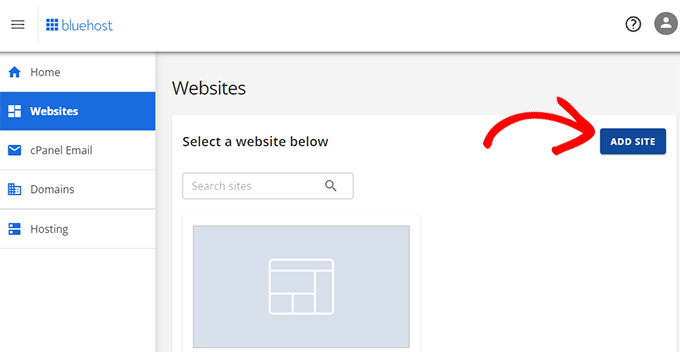
Bitte denken Sie jedoch daran, dass die meisten Shared-Hosting-Konten nur über begrenzte Serverressourcen verfügen.
Ein plötzlicher Anstieg des Datenverkehrs auf einer Ihrer Websites wirkt sich auf die Leistung und Geschwindigkeit aller anderen Websites desselben Kontos aus.
Wenn Sie gerade erst anfangen, dann können Sie das mit Shared Hosting tun. Denken Sie daran, dass Sie auf verwaltetes WordPress-Hosting aufrüsten müssen, wenn Ihr Unternehmen wächst.
Sehen wir uns also an, wie man WordPress ganz einfach in einem Unterverzeichnis installiert.
Schritt 1: Erstellen eines Unterverzeichnisses unter dem Root-Domänennamen
Zunächst müssen Sie ein Unterverzeichnis oder einen Ordner unter der Haupt-Website erstellen. Hier werden Sie die WordPress-Dateien installieren.
Verbinden Sie sich mit Ihrem WordPress-Hosting-Account über einen FTP-Client oder den Dateimanager im cPanel.
Sobald Sie verbunden sind, gehen Sie zum Stammordner Ihrer Website. In der Regel ist dies der Ordner /public_html/.
Sie werden Ihre WordPress-Dateien und -Ordner sehen, wenn Sie WordPress bereits im Stammverzeichnis installiert haben.
Klicken Sie dann mit der rechten Maustaste und wählen Sie im Menü „Neues Verzeichnis erstellen“.
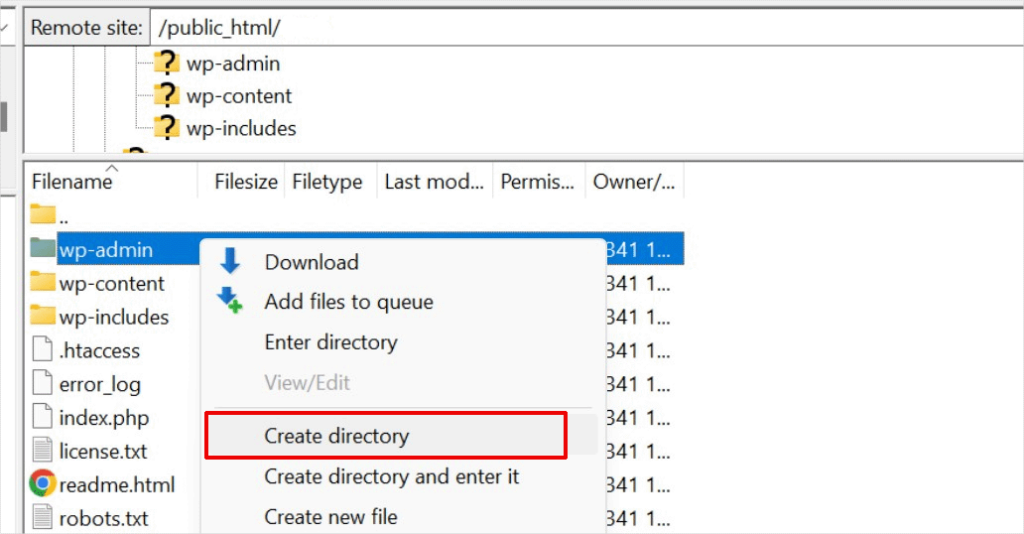
Bei der Wahl des Namens für Ihr Unterverzeichnis müssen Sie vorsichtig sein. Dieser wird Teil der URL Ihrer neuen WordPress-Website sein und das, was Ihre Nutzer in ihren Browsern eingeben werden, um diese Website zu erreichen.
Wenn Sie dieses Verzeichnis zum Beispiel travel-guides nennen, lautet die Adresse Ihrer WordPress-Website:
http://example.com/travel-guides/

Schritt 2: WordPress-Dateien hochladen
Ihr neu erstelltes Unterverzeichnis ist im Moment noch leer. Lassen Sie uns das ändern, indem wir WordPress-Dateien hochladen.
Zunächst müssen Sie die Website WordPress.org besuchen und auf die Schaltfläche „Herunterladen“ klicken.
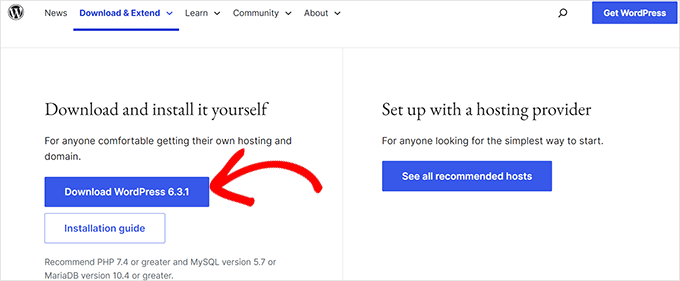
Ihr Browser wird nun die Zip-Datei mit der neuesten WordPress-Software auf Ihren Computer herunterladen.
Nachdem Sie die Datei heruntergeladen haben, müssen Sie sie auswählen und entpacken.
Mac-Benutzer können auf die Datei doppelklicken, um sie zu extrahieren, und Windows-Benutzer müssen mit der rechten Maustaste klicken und dann die Option „Alle extrahieren“ wählen.
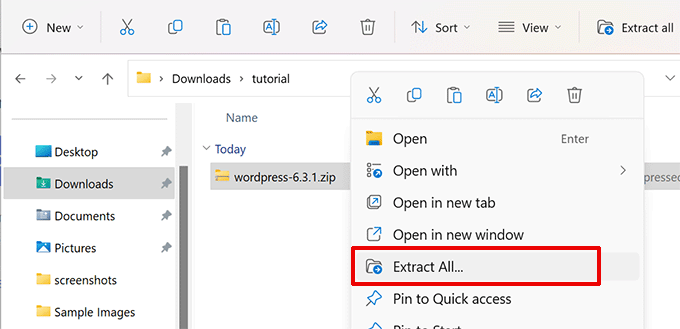
Nach dem Entpacken der Zip-Datei sehen Sie einen Ordner „wordpress“.
Innerhalb des WordPress-Ordners finden Sie alle WordPress-Kerndateien und -Ordner.
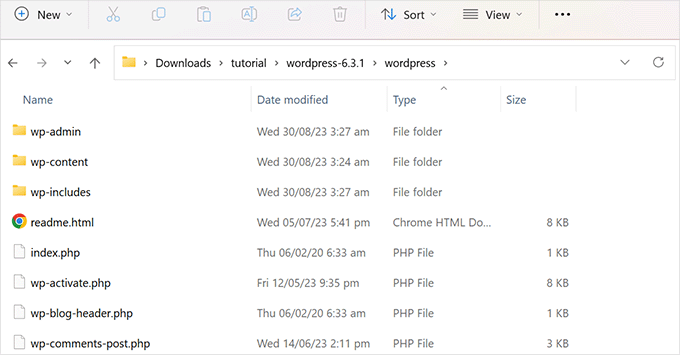
Laden wir nun diese Dateien in Ihr neues Unterverzeichnis hoch.
Stellen Sie mit einem FTP-Client eine Verbindung zu Ihrer Website her und wechseln Sie zu dem Unterverzeichnis, das Sie im ersten Schritt erstellt haben.
Wechseln Sie im Fenster „Lokale Dateien“ Ihres FTP-Clients zum Ordner „wordpress“, den Sie gerade entpackt haben.
Wählen Sie alle Dateien in dem Ordner aus und laden Sie sie dann in Ihr neues Unterverzeichnis hoch.
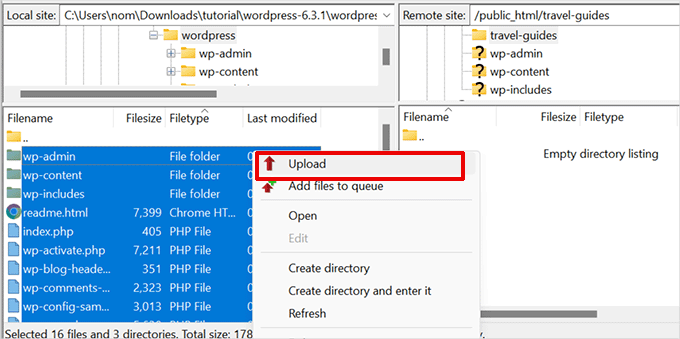
Schritt 3: Erstellen einer neuen Datenbank
WordPress speichert alle Ihre Inhalte in einer Datenbank. Sie müssen eine neue Datenbank erstellen, in der Ihre neue WordPress-Site in einem Unterverzeichnis installiert ist.
Loggen Sie sich zunächst in das Dashboard Ihres WordPress-Hosting-Kontos ein und klicken Sie auf die Schaltfläche „Einstellungen“ unterhalb Ihrer Website.
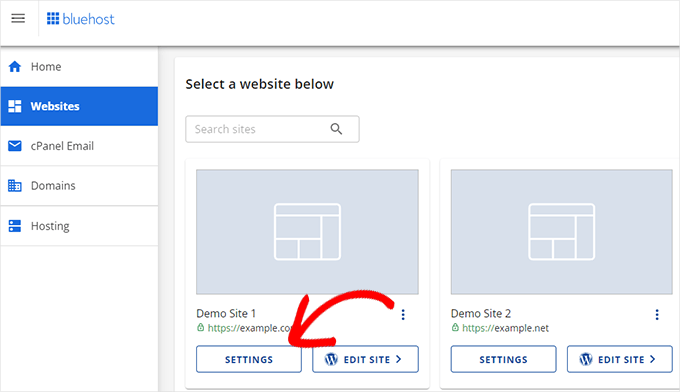
Wechseln Sie anschließend im oberen Menü auf die Registerkarte „Erweitert“.
Scrollen Sie ein wenig nach unten zum Abschnitt cPanel und klicken Sie dann auf „Verwalten“.
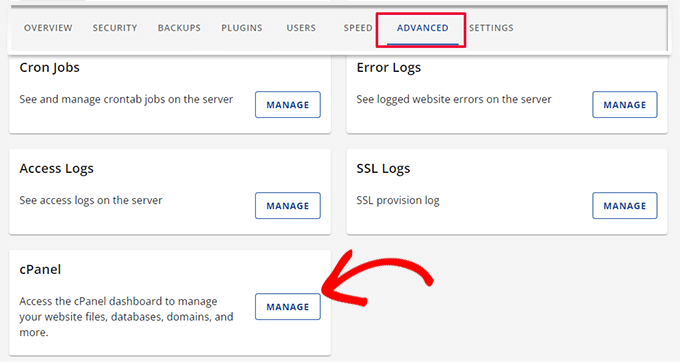
Dadurch wird das cPanel oder das erweiterte Hosting-Kontrollzentrum gestartet.
Von dort aus müssen Sie unter dem Abschnitt Datenbanken auf „MySQL-Datenbanken“ klicken.
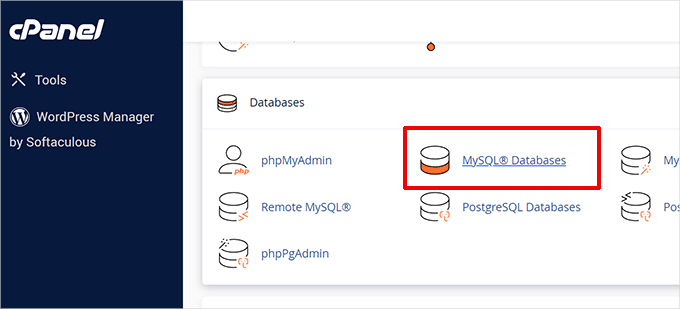
Hinweis: Ihr Hosting-Dashboard sieht möglicherweise anders aus als auf dem Screenshot oben. Sie müssen lediglich den Abschnitt „Datenbanken“ finden.
Geben Sie auf dem nächsten Bildschirm den Namen Ihrer neuen Datenbank ein und klicken Sie auf die Schaltfläche „Datenbank erstellen“, um fortzufahren.
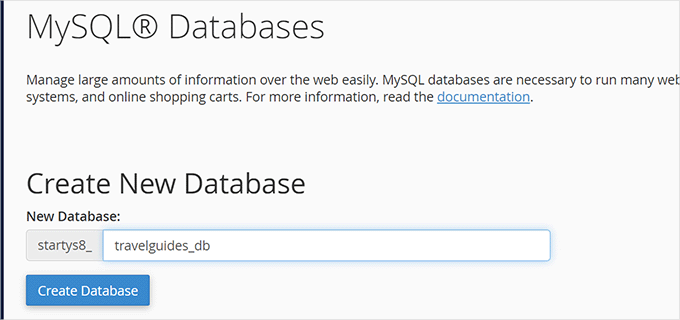
Ihr cPanel-Dashboard wird nun die neue MySQL-Datenbank erstellen. Klicken Sie auf die Schaltfläche „Zurück“, um zur Seite „Datenbanken“ zurückzukehren.
Als nächstes müssen Sie einen Benutzernamen und ein Passwort für die Datenbank hinzufügen.
Blättern Sie einfach zum Abschnitt „MySQL-Benutzer“ und geben Sie einen neuen Benutzernamen und ein Passwort ein. Klicken Sie auf die Schaltfläche „Benutzer erstellen“, um fortzufahren.
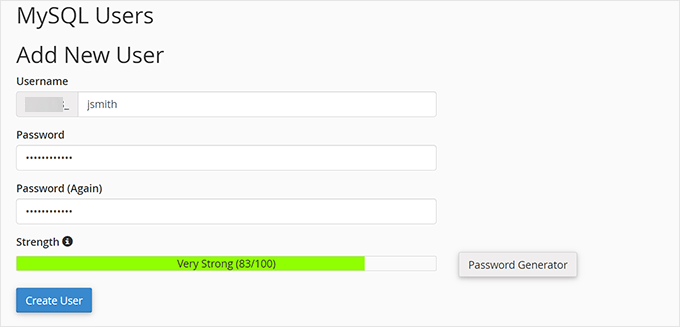
Als Nächstes müssen Sie diesem neu erstellten Benutzer Rechte für die Arbeit an der Datenbank geben, die Sie zuvor erstellt haben.
Blättern Sie nach unten zum Abschnitt „Benutzer zur Datenbank hinzufügen“. Wählen Sie Ihren MySQL-Benutzernamen und dann die neu erstellte Datenbank aus.
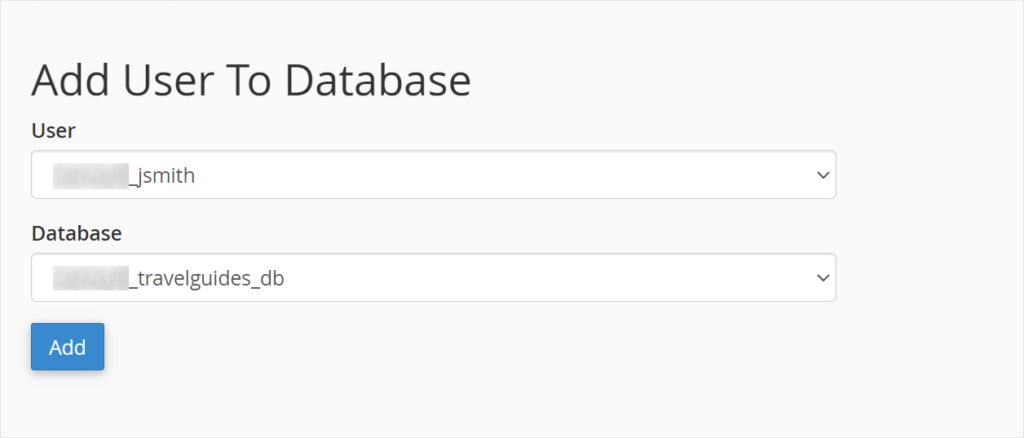
Klicken Sie auf die Schaltfläche „Hinzufügen“, um fortzufahren.
Cpanel wird dem MySQL-Benutzer nun volle Rechte für Ihre neu erstellte Datenbank gewähren.
Schritt 4: WordPress installieren
Nun, da alles an seinem Platz ist, können Sie WordPress installieren.
Rufen Sie das Verzeichnis, das Sie zuvor erstellt haben, in einem Webbrowser auf, indem Sie die URL wie folgt eingeben:
http://example.com/your-subdirectory-name/
Daraufhin wird der WordPress-Installationsassistent aufgerufen. Wählen Sie zunächst die Sprache für Ihre WordPress-Website aus und klicken Sie auf die Schaltfläche „Weiter“.
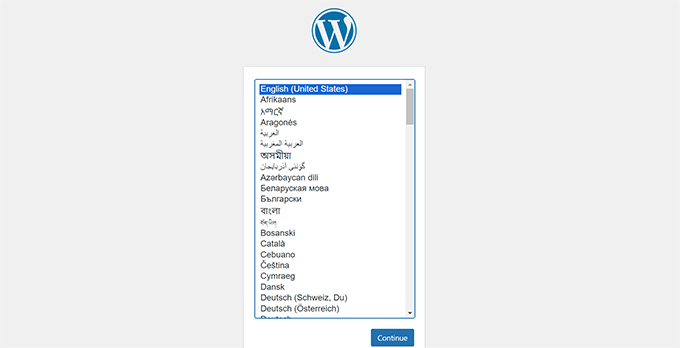
Als Nächstes werden Sie aufgefordert, den Namen Ihrer WordPress-Datenbank, den Benutzernamen der Datenbank, das Passwort und den Host anzugeben.
Geben Sie die Datenbankdaten ein und klicken Sie auf die Schaltfläche „Senden“.
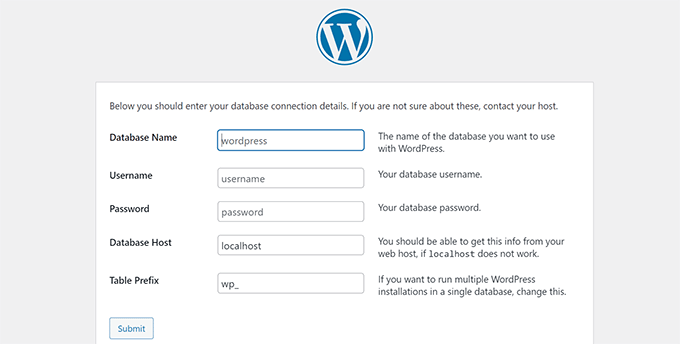
WordPress wird nun eine Verbindung zu Ihrer Datenbank herstellen.
Nachdem eine Verbindung hergestellt wurde, sehen Sie eine Erfolgsmeldung wie diese:
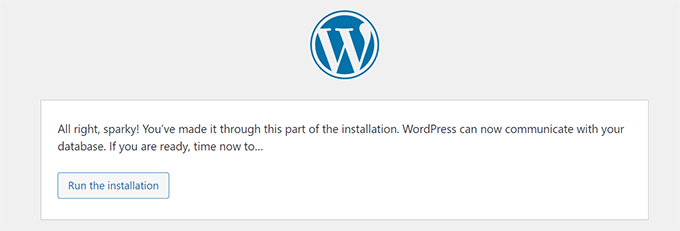
Klicken Sie auf die Schaltfläche „Run the install“, um fortzufahren.
Auf dem nächsten Bildschirm werden Sie aufgefordert, einen Titel für Ihre Website anzugeben und einen Administrator-Benutzernamen, ein Passwort und eine E-Mail-Adresse zu wählen.
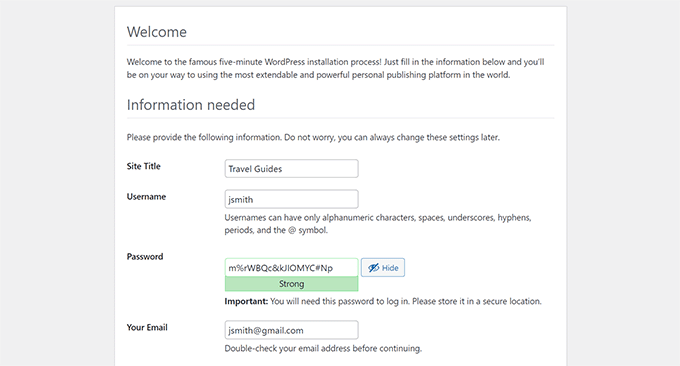
Nachdem Sie die Details Ihrer Website eingegeben haben, klicken Sie auf die Schaltfläche „Installation ausführen“, um fortzufahren.
WordPress wird nun Ihre Website einrichten und Ihnen eine Erfolgsmeldung anzeigen:
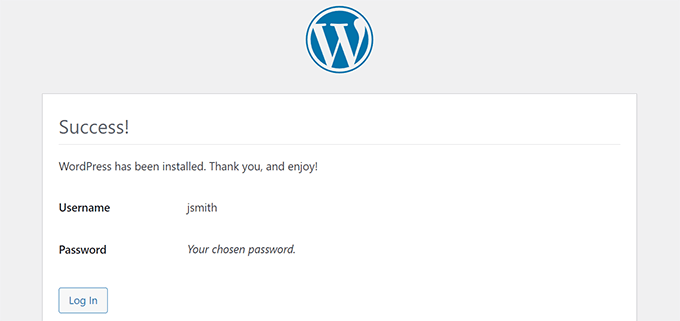
Sie können sich nun in Ihre neue WordPress-Website einloggen, die in dem Unterverzeichnis installiert ist.
Schritt 5: Permalinks reparieren
Wenn Sie eine separate WordPress-Installation im Stammverzeichnis haben, verursachen die .htaccess-Dateien Ihres Unterverzeichnisses einen Konflikt. Dies wird zu 404-Fehlern auf Ihrer Website führen.
Um dieses Problem zu lösen, müssen Sie die .htaccess-Datei in Ihrem Unterverzeichnis WordPress install bearbeiten. Ersetzen Sie den Code in Ihrer .htaccess-Datei durch den folgenden Code:
# BEGIN WordPress
<IfModule mod_rewrite.c>
RewriteEngine On
RewriteBase /your-subdirectory/
RewriteRule ^index\.php$ - [L]
RewriteCond %{REQUEST_FILENAME} !-f
RewriteCond %{REQUEST_FILENAME} !-d
RewriteRule . /your-subdirectory/index.php [L]
</IfModule>
# END WordPress
Vergessen Sie nicht, /Ihr-Unterverzeichnis/ durch den Namen Ihres Unterverzeichnisses zu ersetzen.
Wir hoffen, dass dieser Artikel Ihnen geholfen hat, WordPress in einem Unterverzeichnis zu installieren. Vielleicht interessiert Sie auch unsere ultimative Schritt-für-Schritt-Anleitung für WordPress-SEO für Anfänger.
Wenn Ihnen dieser Artikel gefallen hat, dann abonnieren Sie bitte unseren YouTube-Kanal für WordPress-Videotutorials. Sie können uns auch auf Twitter und Facebook finden.





Syed Balkhi says
Hey WPBeginner readers,
Did you know you can win exciting prizes by commenting on WPBeginner?
Every month, our top blog commenters will win HUGE rewards, including premium WordPress plugin licenses and cash prizes.
You can get more details about the contest from here.
Start sharing your thoughts below to stand a chance to win!
Prem Krishnan P says
I have installed WordPress on the subdirectory. (i.e)www.example.com/blog) and now I created a test post (i.e.)www.example.com/blog/test. Is it possible to remove the subdirectory from the url? Looking something like this example.com/test (i.e)www. Rootsitename.com/Postname
WPBeginner Support says
If you want to do that then we do not have a specific recommendation to achieve that and it would likely be best to place the post on your primary domain to achieve that.
Admin
Jiří Vaněk says
This can be done using the .htaccess file, which is the Linux apache configuration file. It is possible to upload rules to this file, which can be used to rewrite URL addresses in the browser. However, it is a relatively complex topic and it is necessary to approach such an intervention sensitively.
Yevhenii Korchak says
Thanks for the tutorial! Very helpful. You’re the best
WPBeginner Support says
Thank you and glad to hear our tutorial was helpful!
Admin
Mangkutak says
is this type of wordpress installation still can enable multisite feature if i want it to enable for my wordpress site. i heard that before long time ago that’s not possible, is that still the case today?
WPBeginner Support says
You can convert a site to a multisite installation.
Admin
Mohammed says
hello,
I did the same steps, once I installed WordPress and do some tests I found that cannot make save posts or publish them. an error message appears
Updating failed. The response is not a valid JSON response.
please help.
WPBeginner Support says
For the invalid JSON error, we would recommend going through our article below!
https://www.wpbeginner.com/wp-tutorials/how-to-fix-the-invalid-json-error-in-wordpress-beginners-guide/
Admin
alan says
Thanks for this tutorial. I wasn’t sure if I had to previously create the database or make it during the install process.
WPBeginner Support says
Glad our guide was helpful!
Admin
Giwa says
Hello, this steps are self explanatory but in my case, our main website doesn’t run on WordPress however we want to run WordPress on a sub-directory /blog.
How do we go about this
the main website runs on NodeJs
WPBeginner Support says
You should still be able to follow the steps in this guide for what you’re wanting to do.
Admin
Abid Hasan says
Today I’ve set up my new WordPress inside sub-directory. Didn’t need to change the .htaccess file. I think WP is so smart now that can handle this automatically.
WPBeginner Support says
Thanks for sharing, your hosting provider may have also set it up for you when installing as certain hosts set that up for you now.
Admin
Goran says
Thanks a lot for great tutorial whithout any issues.
WPBeginner Support says
Glad our guide was helpful
Admin
Sam says
Thank you for this guide.
We are planning to have subdirectories on our next website. This guide really cleared the air.
One question though,
Is there a limited to how many subdirectories a WordPress website can have?
WPBeginner Support says
There is not a hard limit to the number of directories at the moment.
Admin
Swetha says
Hi.. thanks for this article… am unable to upload the folders wp-admin, wp-content and wp-includes in the sub directory… rest other files are uploaded.. how do I upload all of these???
WPBeginner Support says
It would depend on why you are unable, if you reach out to your hosting provider they should be able to assist but it may be a permissions issue with your user.
Admin
Arinze says
Thanks it worked.
Is it possible to the subdirectory name on the URL, for example example.com/seo/how-to-rank to example.com/how-to-rank
WPBeginner Support says
If you would like your URLs not to have the subdirectory in the URL we would recommend installing the site on your primary domain rather than creating redirects to remove it from the URL.
Admin
Arinze says
Thanks for this article. It is very insightful.
Will the installation of WordPress on the sub folder affect the overall speed of the site.
WPBeginner Support says
It should not
Admin
dennis wille says
there is an apparent error in your htaccess code example
should be
# BEGIN WordPress
RewriteEngine On
RewriteBase /your-subdirectory/
RewriteRule ^index\.php$ – [L]
RewriteCond %{REQUEST_FILENAME} !-f
RewriteCond %{REQUEST_FILENAME} !-d
RewriteRule . /your-subdirectory/index.php [L]
# END WordPress
note rewriterule line 5 change
WPBeginner Support says
Thank you for catching that, while not specifically required, we’ll look to update the article
Admin
Deddy Hidayat says
I want to build a web with a wordpress subdirectory, the first web is domain.com, and the second web is domain.com/blog … as far as I know wordpress uses domain.com/blog as the default post … will it hurt SEO?
WPBeginner Support says
WordPress does not use /blog as a default, that is only the most common URL to use. Using blog for a subdirectory should not have a major effect on SEO.
Admin
Shashank Dubbewar says
is it necessary to install and manage same plugins separately if I installed wordpress on main domain and sub directory each and manage wordpress sites separately ?
WPBeginner Support says
If it is on a different site even on a subdirectory, the plugins are managed for each individual site. You could also take a look at some recommended tools for managing multiple sites in our article below:
https://www.wpbeginner.com/showcase/how-to-easily-manage-multiple-wordpress-sites/
Admin
Mohd Kaleem says
Hello Sir, Can I create Subdirectory without login Cpanel. I forgot My Hosting Details. But I have WP details, is it possible to create subdirectory using wordpress any plugin or other way?
WPBeginner Support says
You would need access to your hosting, you should be able to reach out to your hosting provider for assistance in being able to log back into your account.
Admin
Kosi says
Thank you. This worked! Really grateful….
WPBeginner Support says
You’re welcome, glad our guide was helpful
Admin
Nicoleiver says
Hi, I would like to ask is it possible to copy all the file from my current folder to the sub directory? Because I want to have the same template and plugin for my sub directory site.
WPBeginner Support says
For a starting point, you could take a look at our guide on how to make a staging site below and instead of installing the site on staging you could have all of your content on the subdomain of your choice and modify the content to be that of your new site. You can find our guide on setting up a staging site below:
https://www.wpbeginner.com/wp-tutorials/how-to-create-staging-environment-for-a-wordpress-site
Admin
John Doe says
What if the I created a new subdirectory from another subdirectory, should the fix permalink still be relevant and work with no problem?
For example, I have firstwebsite.com/firstsubdir/ the second subdirectory will be firstwebsite.com/firstsubdir/secsubdir/ should I still use the same fix for the permalink?
Sorry English is not my first language.
WPBeginner Support says
You would need to include the second subdirectory in the permalink change and it should still work.
Admin
keram says
Thanks for a clear tutorial.
Is it possible to install WP in a subdirectory but use the main domain URL to access it and still have the main URL displayed in the browser address bar?
To clarify:
I would install WP in mydomain.com/sub/ but would like to access it by opening mydomain.com and have mydomain.com displayed in the browser so that visitors can bookmark my URL.
Is it possible to set it up?
WPBeginner Support says
It is possible but would depend on your hosting provider to see if it is allowed. If you reach out to your hosting provider they should be able to assist.
Admin
keram says
Will the pages load faster if WP is installed in the subdirectory?
WPBeginner Support says
Where your site is installed on your host shouldn’t affect your site’s loading time to a noticeable degree
Ghulam Mujtaba says
Salam, I just finished reading the article and i have question, how can i have the same header and footer from the wordpress installation in parent directory? I’ll be glad and thankful to you if you give me a clue, Thanks…
WPBeginner Support says
For that, the simplest method would be to install the same theme on both sites.
Admin
Priscilla says
Hello,
Thans for this awsome tuto, it works!
WPBeginner Support says
Glad our guide was helpful
Admin
Sohail says
Really helpful! One question please.
Do I have to add this line:
RewriteBase /your-subdirectory/
for every install in a sub directory in main WordPress installation?
Thanks
WPBeginner Support says
Yes, we would recommend this to prevent any issues on the subdirectory
Admin
Samantha says
Thank you for this information! Helped me a lot!
WPBeginner Support says
You’re welcome, glad our guide could help
Admin
Alex says
Hi. I manually copied my WordPress files to the root folder, without the plugin. I then copied the original database in a new one, where I replaced the siteurl to reflect the new location, the root folder. In the wp-config file at the root folder, I changed WP_HOME and WP_SITEURL to remove the /wordpress.
As a result, I was able to reach the wp-login for my new location, but no further.
And when I visited my site, I was getting a warning „too many redirections“.
Any advice?
WPBeginner Support says
There are a few possible reasons, for a starting point, you would want to go through the steps in our article here: https://www.wpbeginner.com/wp-tutorials/how-to-fix-error-too-many-redirects-issue-in-wordpress/
Admin
Abhishek mahajan says
Thanks a lot for WP subfolders step by step guide. One thing that i never undersatnd is how to create a exact Google news xml sitemap in WordPress?
WPBeginner Support says
Most SEO plugins should add the required markup for you to be able to be added to Google News. If you are using an SEO plugin you would want to reach out to the plugin’s support for what they recommend for setttings.
Admin
Hesam says
Thanks for your article. I have a question about transforming this sub domain or sub directory installed word press to main root of website and replace it with the main site. what should I do?
WPBeginner Support says
It would depend on what you mean, you could take a look at our guide here: https://www.wpbeginner.com/wp-tutorials/how-to-get-rid-of-wordpress-from-your-wordpress-site-url/
Admin
Umesh Yellaboina says
Hi Team, Thanks for this post, not only these… all the other posts in your blog are very helpful to us, I really appreciate your works. Thanks a lot for these.
And need a little help, actually did the same as in this post, installed wordpress in a sub directory, but I’m face a little issue, i.e. I’m unable to receive the emails from contact form, when it was on sub-domain it’s working fine, but when it is installed on sub-directory not receiving the form submissions, it’s going on loading but not getting submitted. Please help me with this. Thank you.
WPBeginner Support says
If they’re not being stored in your site if they should when submitted you would want to reach out to your form plugin’s support. If you are not receiving an email then you would likely want to use SMTP: https://www.wpbeginner.com/plugins/how-to-send-email-in-wordpress-using-the-gmail-smtp-server/
Admin
David says
Thanks for the info. I read every post you write.
Just I’ve a doubt. I created a new WP Install trough my Host provider, but searching, there is no .htaccess file in the subdirectory. It’s mandatory to have a new .htaccess file? it’s going to create errors in the future?
WPBeginner Support says
WordPress should generate the htaccess file if you resave your permalinks. If you still don’t see it you may not have the option to show hidden files enabled
Admin
Rubens says
thankkkkkkkssssssss <3
WPBeginner Support says
You’re welcome
Admin
Eulises Quintero says
Hello, I successfully installed WordPress in a subdirectory around 3 weeks ago, I already uploaded a theme, some plugins and made some posts. Question, can I change the name of my subdirectory? How? the name is Chose for my subdirectory and what shows after my original website URL is español, I want to make it es, I want to change this because I read somewhere that characters like ñ might cause some issues in terms of SEO….so now I’m worried, thank you for your time
WPBeginner Support says
If the site has been set up for some time, you would want to follow the steps in our article here: https://www.wpbeginner.com/wp-tutorials/how-to-properly-move-wordpress-to-a-new-domain-without-losing-seo/
If you recently installed it on the subdomain then you wouldn’t need to notify Google
Admin
Mosiur Rahman says
Hey, I just followed the process except i haven’t changed the htaccess file. My site is still working properly. I am using hostinger.
is changing the htaccess mandatory ? will it cause error in the future?
WPBeginner Support says
Your host may have set up the redirect for you, if you reach out to your host they should be able to let you know.
Admin
Owaiz Yusufi says
Just got it to work but little bit worried, does it increases my load time of both pages. I mean to say that
( currently I have made this on localhost for test but I am going to implement it in one or two days on my main server )
I have two website but single domain
Just want to know that does this will increase the bandwidth useage and load time.
Let’s suppose if I my main webpage size 1 mb and my second website size is also 1 mb so when someone load the main page does it loads all the 1+1 2mb size.
WPBeginner Support says
Hi Owaiz,
Yes it will increase bandwidth usage depending on your traffic. Since both WordPress installs share the resources, traffic load on one website will affect the performance of other website as well.
Admin
billybob says
Wow, worked first time! Thank you so much!!
maxime says
Thank you very much, clear and working
Mauwiks says
My site got a white screen of death after this.
Shankar says
Really Its very useful for beginners to install
Karen says
Hello, I dont understand something. What is the difference between installing wordpress in a subdirectory and just creating multiple pages???
I am a noob
Simson says
I think I did everything as shown in your instructions. But the trouble I’m having is when I’m trying to customize my theme on the subdirectory it taking me to the root domain wp customizer. What should I do then… ?
Yoki andika says
Hello, can you help me?
I installed my local wordpress to the subdir with ftp but the problem is the css doesn’t work properly, and i don’t know what’s wrong with my wordpress, because i follow this step.
Maybe Anyone can help?
Thank you
Kandra says
Hi,
I am following the steps that you have recommended in creating the sub directory, but than I see the following error,
When I trying to open the URL after uploading all the files to the folder through FTP,
I see the URL redirecting to wp-admin/setup-config.php & throwing an server error 500 (This page isn’t working
simplyrent.in is currently unable to handle this request.
HTTP ERROR 500)
Jyotishman Nath says
I have heard that subdirectories are treated as part of root domain in terms of ranking.But my subdirectory is not ranking, even for exact match keyword search.I have indexed Subdirectory using Fetch as Google Tool.I don’t know what is the problem?
I have submitted it to Search Console, Created separate robot.txt and sitemap (Sitemap is pending from last two days).
Should I give more time to Google to Crawl by Subdirectory?
Please Replay.
Thanks!
WPBeginner Support says
Hi Jyotishman,
It is up to search engines to decide how they would rank your website in their results. All you can do is optimize your website for SEO and follow the best practices.
Admin
Layon says
Thank you for this tutorial. It saved me after hours trying to understand why I was getting 404 errors all day long.
Johnny says
just put this in your .htaccess
DirectoryIndex index.php
thank me later!
TH says
Question: Login for main and subdirectory
Hi. I created a subdirectory with a separate WP install.
It looks like the user has to create an account for the main and subdirectory and to login for both the main and subdirectory.
Is there a way to let a user who has login to either the main or subdirectory site to have access to the other site without having to login again? i.e if user has login into main site, he/she does not need to login to the subdirectory site. and vice versa.
Thanks.
TH
Dragos says
By default, if you are using softaculous, you are installing wordpress to the default directory named wp. You don’t need to install manually WordPress in a directory/ subdomain, you only need to change the name of the directory where you want Softaculous to install WordPress and it will also make a database and so on.
medmouncef says
Thanks for this tutorial.
It would be interesting to show, when you have a little time of course, how to configure cPanel redirects to this subdirectory. For example, I can’t redirect my domain name to a WordPress subdirectory créé sous /public-html.